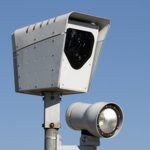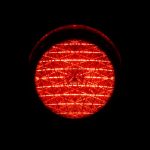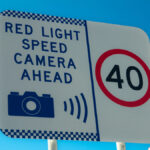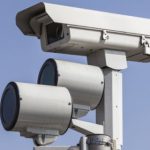Can I Be Fined for Not Stopping at a Yellow Traffic Light in NSW?
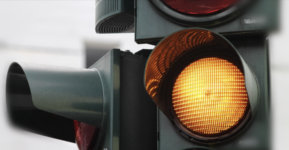
Many drivers typically think that the yellow traffic light, sometimes known as the ‘amber light’ is a bit of a ‘grey’ area in terms of traffic offences. Some believe it’s ok to go through, others believe that you need to slow down and stop.
So who is right?
The Road Rules 2014 (NSW) make clear that drivers and riders must slow down when a traffic light turns to yellow/amber, and stop at the marked line, or as close as possible to the line on the road, unless it is unsafe to do so.
An ‘unsafe situation’ is one when slamming on your brakes might mean that the car behind you doesn’t have time to react, and cause an accident. This would be likely to be the case if you were travelling at significant speed, or if the car behind you was very close to your rear bumper.
Rule 57 of the Road Rules 2014, states that when it comes to yellow or amber lights, you must stop, if it is safe to do so.
How much is the fine?
At the time of writing, failure to stop will incur a $469 fine and 3 demerit points.
The fine increases to $587 and 4 demerit points if you’re within a school zone.
Taking the matter to court
If you elect (choose) to take the matter to court, plead not guilty and are found not guilty, there is of course no penalty.
If you elect and plead guilty, the magistrate has discretion to deal with you by way of a ‘non conviction order’ such as a section 10 dismissal, in which case you will not have a fine or incur demerit points, although the court may render a levy for court costs.
However, it’s important to note that if you plead not guilty and are ultimately found guilty, the court-imposed fine can be as high as $2,200.
Proceed with caution
New South Wales drivers are asked to use some sensible judgement when it comes to the yellow light. Amber lights can denote a hazard ahead and they mean ‘caution’ – usually they are the default display if traffic lights aren’t working properly. If this is the case, and there are no police officers directing traffic, then drivers need slow right down and take extra care.
However, if you are approaching a normal, fully operational traffic light that turns amber and you do decide to proceed through it, then you must do so at the same speed you’re already travelling.
Amber turns to red
Speeding up to get through the light could mean that you get caught driving over the designated speed limit. Any subsequent speeding fine would be determined by the speed you were travelling in comparison to the marked speed limit for that particular road.
Remember though, that If you do decide to go through an amber light, you do increase your chances of the light turning red.
The penalty for failing to stop at a red light is currently $469 fine and 3 demerit points.
Cameras are everywhere
And, if you think you won’t get caught, think again. The New South Wales Government has invested heavily in a state-wide network of cameras, installed at traffic lights and other random locations. In addition there are mobile cameras, and all police vehicles are fitted with speed detectors.
New South Wales police cars are fitted with sophisticated fixed and hand-held speed check devices (LIDAR and RADAR).
The standard fixed radar can be configured in two different modes: mobile mode, or when officers are on the move, and stationary mode. Police vehicles in NSW are capable of obtaining speeds of vehicles approaching from long distances – in some cases up to 600 metres away.
Detecting unregistered and stolen vehicles
Since 2013, police patrol cars in New South Wales have also been fitted with devices capable of reading up to six number plates per second. Cameras mounted on the car itself link to a computer which runs optical recognition software along with a database of stolen, unregistered or suspect vehicles, which sounds an alarm every time it finds a match. This alerts an officer to pull over the ‘matched’ vehicle and issue a fine.
Similarly, if your car is unregistered at the time an infringement is recorded by a camera, it will be detected and you will be fined accordingly.
Many drivers have been caught out with unregistered vehicles because we no longer use the old system with a ‘sticker’ on the windscreen which was always a good reminder of when rego was due. So, drivers must be vigilant and ensure that registration is kept up to date. This can be paid either via the Services NSW website, app, or in person, at any one of the branches.
If your registration is out of date by more than 3 months, you need to re-register the vehicle, you cannot simply renew registration. Re-registration is a different process and requires more mechanical checks to ensure the vehicle is roadworthy.
There is no publicised ‘grace’ period for out of date registration, but if your renewal is only late by a few days, you may be shown some lenience if you have a good excuse – such as you were out of the country, your notification did not arrive in time, you were in hospital, for example.
You still may receive a fine though, and then you will have the option to pay it, or to dispute it.
Requesting a review
You can request a review of a fine (fine notice, fine reminder notice or overdue fine) if you believe a mistake has been made, or there were special circumstances that led to the offence.
To do this, you must apply to Revenue NSW for a review, and the review team will consider your personal situation and any special circumstances that resulted in you receiving the fine.
The team may determine that the fine will stand, or that it will be waived. In cases where the determination is that the fine stands, you can take the matter to court.
If you have had a driver’s licence for more than 10 years and have a clear driving record, you may be eligible for a caution in relation to some offences, however cautions do not apply for serious offences. These include but are not limited to: red light offences, mobile phone offences, high-speed offences, and school zone offences.
Data-Backed Information
Stopping at a yellow light is not only the safest thing to do on the roads, and mandated by the Road Rules 2014 (NSW), but it can help prevent numerous accidents and crashes.
Red light cameras can end up in hefty fines, but they end up saving lives. Almost 1 million tickets were issued to drivers between January 2018 and 2024 — but this almost-one-million tickets led to a 79% reduction in fatalities at the associated intersections. Between 2019 and 2023, there were nearly 2,000 crashes that were attributed to disobeying traffic signals.


